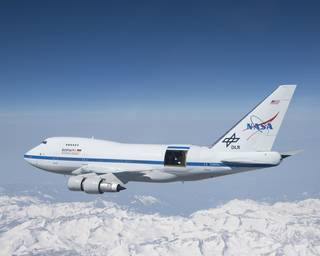Water on the Moon: a discovery, an estimate, and why it matters
Earth’s Moon
- The Moon is Earth’s only natural satellite and the fifth largest moon in the solar system.
- The Moon’s presence helps stabilize our planet’s wobble (movement side to side), which helps stabilize our climate.
- The Moon’s distance from Earth is about 240,000 miles (385,000km).
- The Moon has a very thin atmosphere called an exosphere. It is not breathable.
- The Moon’s entire surface is cratered and pitted from impacts.
- The Earth and Moon are tidally-locked. Their rotations are so in sync we only see one side of the Moon all the time. Human’s didn’t see the lunar far side until a Soviet spacecraft flew past in 1959.
- So the moon has two sides to it, one the sunlit surface and other the dark surface.
SOFIA telescope

- Stratospheric Observatory for Infrared Astronomy, (SOFIA) is a Boeing 747SP aircraft modified to carry a 2.7-meter (106-inch) reflecting telescope.
- It flies at around 45,000 ft to put it above 99 percent of Earth’s infrared-blocking atmosphere, allowing astronomers to study the solar system and beyond in ways that are not possible with ground-based telescopes.
- It is designed to observe the infrared universe.
What is in the news?
- In the Nature Astronomy, two of the reports predicted that there are potentially huge implications for sustaining humans on the Moon in the future. One study reports the detection of water on the Moon’s sunlit surface for the first time. The other estimates that the Moon’s dark, shadowy regions, which potentially contain ice, are more widespread.
Why is the discovery of water important?
- Water is vital for human establishments. Water is not only important for human sustenance but also to generate rocket fuel.
- Research organisations are moving towards sustainable human presence on the moon.
- NASA’s Artemis programme plans to send the first woman and the next man to the Moon in 2024. If we could get access to the moon’s water we can reduce the transport of water from earth to the moon.
How water could have formed on the moon?
- Space rocks carrying small amounts of water could have bombarded the Moon.
- Or the Sun’s solar wind could have carried hydrogen, which then reacted with minerals in the lunar soil to create hydroxyl, which later transformed into water.
Chronology
- It was Chandrayan I of ISRO which first detected the water molecules on the moon. But it was not confirmed whether it was H2O molecules or hydroxyl (OH) molecules.
- Recently SOFIA telescope with its latest technology confirmed the H2O molecules in the brighter side.
- Scientists were amazed how the water molecules survive the sunlight and lack of thick atmosphere on the moon. It has been predicted that water might have got trapped into tiny bead-like structures that were created in the soil by impacts from space rocks. Or water might have got hidden in lunar soil.
Wayforward
- NASA’s Volatiles Investigating Polar Exploration Rover (VIPER) will carry out a mission to create the first water resource maps of the Moon.
- SOFIA is about to look for water in additional sunlit locations to learn more about how the water is produced, stored, and moved across the Moon.
References:
Subscribe
Login
0 Comments
